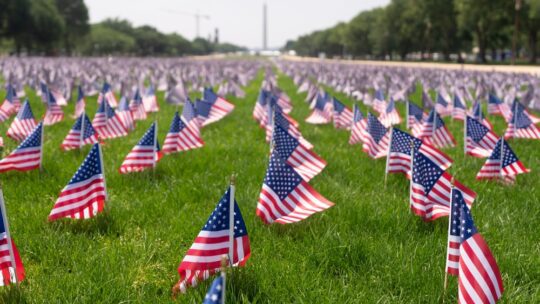
Every year on Nov. 11, the United States observes Veterans Day, a time to honor the men and women who bravely served in the nation’s armed forces. Their legacy of service and sacrifice dates to the founding of the country, to the Continental soldiers who fought for independence.
As we honor those who have served from the Revolutionary War to the present day, it’s important to recognize how the founding generation fought not only on battlefields but also for hearts and minds. From the soldiers who survived the harsh winter at Valley Forge and the minutemen who responded to Paul Revere’s midnight ride, to the patriots who organized the Boston Tea Party, they all played a part in a larger effort that depended on what we now call strategic communications.
What many might not realize is the significant influence public relations efforts had on these historic events. Even though “PR” didn’t exist as a formal industry, the strategies and tactics that form the foundation of the profession played a vital role in shaping the narrative, rallying support and fostering unity before, during and after the Declaration of Independence.
Here are just a few examples of how PR contributed to the founding of the U.S.:
The Boston Tea Party: PR Event
On the evening of Dec. 16, 1773, American colonists, disguised as Mohawk Natives, boarded three British ships and dumped 342 chests of tea, imported by the British East India Company, into Boston Harbor to protest the Tea Act and “taxation without representation.” A bold, calculated piece of political theater that became a symbol of colonial resistance. It served as a powerful PR event, framing the colonists' resistance as a righteous fight against tyranny, which rallied support within the colonies and gained sympathy across Europe. Patriots quickly spread the word about the event, further amplifying its impact as a symbolic act of defiance and a catalyst for revolutionary sentiment.
Join, or Die: Slogans and Symbols
Throughout the American Revolution, patriots used memorable slogans to communicate with and influence the colonies. In 1754, Benjamin Franklin published what is considered the first American political cartoon in the Pennsylvania Gazette. The cartoon showed a rattlesnake cut into eight pieces, representing the U.S. colonies, with the text “Join, or Die,” conveying that unity was essential for survival. The rattlesnake also became a symbol of the colonies because it is found only in the U.S. and signifies self-defense, since a rattlesnake only strikes to protect itself.
"Join, or Die" and the rattlesnake are just two examples of the slogans and symbols used by patriots. Others included:
- No taxation without representation
- Give me liberty, or give me death
- Live Free or Die
- The Liberty Bell and Liberty Tree
- The Stars and Stripes
Patrick Henry: Spokesperson
Long before broadcast and social media, there were only two ways to communicate—in person or through print. During the American Revolution, those who could passionately tell the story of freedom and self-determination were essential in swaying public opinion, inspiring others and unifying the colonies to a common cause. One of these spokespeople was Patrick Henry, the first governor of Virginia and a leading figure in the American Revolution, whose emotional and influential oratory skills helped ignite a movement. Henry is most remembered for his 1775 speech at the Virginia Convention, where he said, “Is life so dear, or peace so sweet, as to be purchased at the price of chains and slavery? Forbid it, Almighty God! I know not what course others may take; but as for me, give me liberty or give me death!”
Thomas Paine’s "Common Sense": Citizen Journalism
Thomas Paine’s 47-page pamphlet, published on Jan. 10, 1776, persuasively and passionately advocated for independence from Great Britain. At a time when many colonists held onto hope for reconciliation with Britain, Paine argued for full and immediate independence. "Common Sense" was written, unlike other political pamphlets of the time, in plain, accessible language aimed at ordinary colonists, rather than elites, thereby expanding participation in the debate about revolutionary ideas. Selling over 100,000 copies in the first few months of publishing, it remains the all-time best-selling American title. Much like today’s citizen journalists, Paine took his views and information directly to the people.
The Federalist Papers: Opinion Editorials
Written by James Madison, Alexander Hamilton and John Jay under the pen name “Publius,” the collection of 85 articles and essays was published in New York newspapers to raise support for the ratification of the newly written U.S. Constitution. At the time, many were deeply skeptical of a strong central government, having fought for independence from Great Britain. Each essay addressed specific objections raised by anti-Federalists, such as the separation of powers, checks and balances, the role of state versus national government and the need for a standing army and national taxation. Much like contemporary thought leaders, these opinion editorials sought to persuasively articulate the Federalist perspective, encouraging readers to think critically and take action.
When one begins to look closely, it’s easy to see how the founding fathers used the strategies and tactics of PR to help galvanize public opinion, spread revolutionary ideas and maintain morale. All of which ultimately underpinned the collective effort that led to independence.
This history should remind us of the power and responsibility that come with being a PR professional. Like our founding fathers, let's not use our skills of persuasion and communication just for vanity’s sake but to create something that benefits future generations.
Jared Meade is Founder and Principal of Rayne Strategy Group, and wrote this piece on behalf of the PR Museum.
